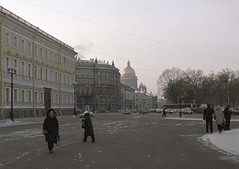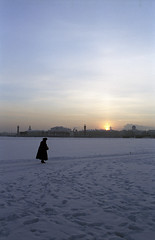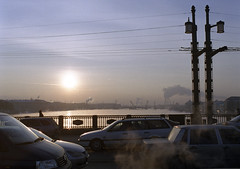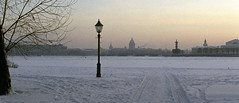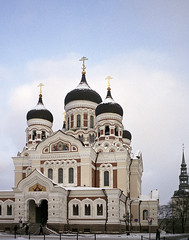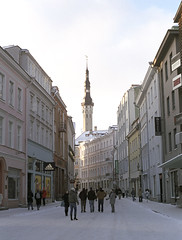Russia
There is a point, when the -22℃ air is biting your face, your friend has just had his camera stolen out of his pocket and you haven't seen a local smile for days that you wonder whether travelling to St. Petersburg in the middle of winter was such a good idea.
Of course the feeling is a brief one - being surrounded by amazing, beautiful buildings each with its own fascinating history in a part of the world inaccessible to the west until the last decade, makes it hard to hate a place.
St Petersburg, the former Russian capital is located at the point where the river Neva meets the Baltic Sea. Being within the Asian landmass gives it a continental climate - warm dry summers and bitterly cold winters. Of course we chose to visit in the middle of winter.
The weather in St. Petersburg really is as cold as people say. During our stay the temperature dropped to -22℃ and never rose above -18. The Russian people shuffle about looking dispirited and unhappy, and I could, after experiencing the icy wind, almost sympathise with them. That, however, is before I take into account St. Petersburg's architecture.
The city's real treasure is its buildings. When the city was being built in 1703, Peter the Great forbade all construction of stone buildings in the rest of Russia, forcing stonemasons to come from all across the country to work on his masterpiece. Well let me say, it was worth the effort. The streets are wide and littered with coliseums, palaces and grand cathedrals. The most famous church is The Church Of Spilled Blood, built on the spot where Alexander II was assassinated. With its onion domes it looks like something out of a Disney film. Of course because we visited in winter it wasn't particularly open - at least we got to see it without the tourists though.
The Hermitage is the 'must see' attraction of St. Petersburg. It houses some of the world's most famous art including, amongst others, 27 Rembrandts. There was some sort of deal on when we visited, so for the price of having hordes of cackling Russian kids swarming around us, we got in free.
Across the river from the Hermitage is the Fortress of Peter and Paul. Within the fortress is a small chapel containing the bodies of all the tsars, each one lying within a plain stone sarcophagus and surrounded by a gold encrusted hall.
History surrounds you wherever you go in St. Petersburg. In some ways the city lives in the past; the metro in St Petersburg is the deepest I've ever seen and also the most opulent. The magnificence of its pillars and chandeliers, however, is masked by a thick and pervading layer of grime. The city is surrounded by miles and miles of rotting concrete skyrises, skeletons of a communist past, which house the residents of the 4th largest city in Europe.
The only major disappointment of the trip was that, despite long searching, we did not find the statue that James Bond drove the tank into in Goldeneye. Further research has revealed that that part of the film was actually shot in a studio in England, and that the statue is fiction.
The canals that the tank drives past are real though. Peter the Great intended his city to be like Venice, navigated by coracles, and it was only much later that bridges were built to connect the city together.
Estonia
A day's journey west of St. Petersburg, along the Baltic coast, is Tallinn, capital of Estonia. Bordered to the North by the frigid Gulf of Finland and to the South by Latvia, Estonia has had a turbulent and chequered history. Occupied by the Red Army in the war, it was 'liberated' by the Germans and then retaken by the Russians, only regaining its independence in 1991. This history has left its mark on the capital. The city centre is flanked by miles of identical rotting grey tower blocks, surrounding it like a besieging army.
It was within one of those tower blocks that we stayed during our visit to Tallinn. Mahtra Youth Hostel is based within one of the flats, its rooms interspersed with the apartments of Tallinn residents. Although the youth hostel was being refurnished, the room we spent our first night in was unchanged, giving a real feel of what life was like when Tallinn was still behind the iron curtain. Most of our time however was spent in the city centre. The change in architecture could not be any more apparent. The centre of Tallinn is quintessentially European, filled with winding alleys, streets sloping surprisingly steeply for the flat city, and ornate church spires. The streets are quiet in the cold winter nights and we spent most of our nights in the city eating within the many Germanic restaurants and sampling the local beers.
The best way to get around the city is on the buses or trams trundling around the icy streets. A more exciting mode of transport is to take a taxi; Estonian taxi drivers seem to delight in driving at great speeds around the snow covered city, sliding perilously close to parked cars and busy junctions.
In the centre of Tallinn within the city walls is the town square. From here small lanes wind up the hill through gates in the walls to the district of Toompea, seat of the Estonian Government, many embassies and the impressive onion domes of Alexander Nevsky Cathedral. From the top of the hill the whole city can be seen spread out below, the concrete skyrises running down to the partly frozen sea.
Despite the bleak weather, The people of Tallinn seemed to show an optimism and friendliness that was a welcome respite from the sullenness of St. Petersburg. Estonia's tourist industry is growing rapidly now it is independent, and since I've been back in Scotland I've noticed more and more references to Estonia as a destination. In any case Estonia has a completely different character to Russia.
In some ways the trip was too short. We didn't see nearly as many places as we would have liked. On the other hand, it was far too cold to stay so far north for any longer. Next time I'm visiting in summer!
